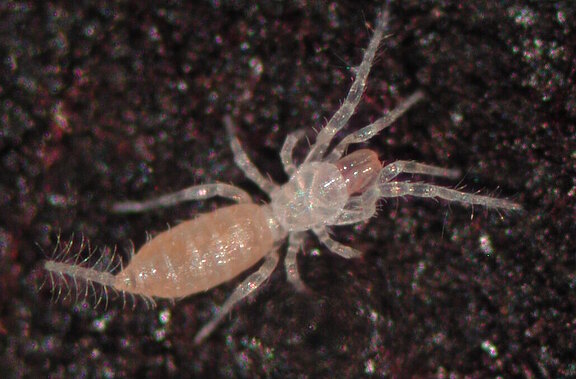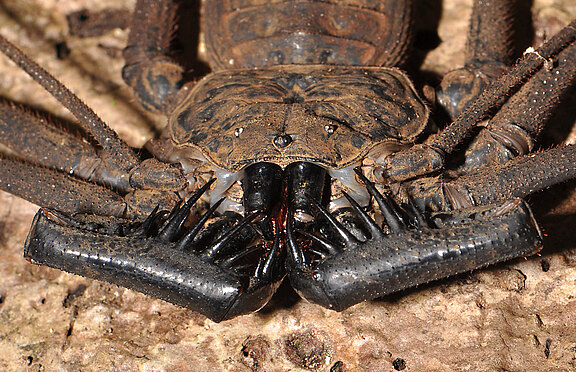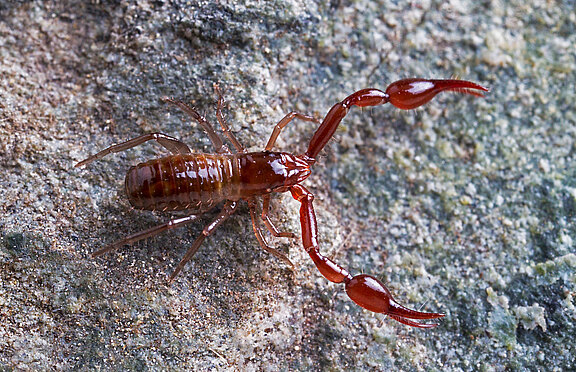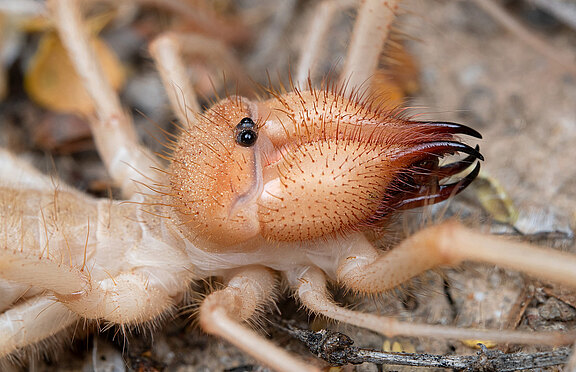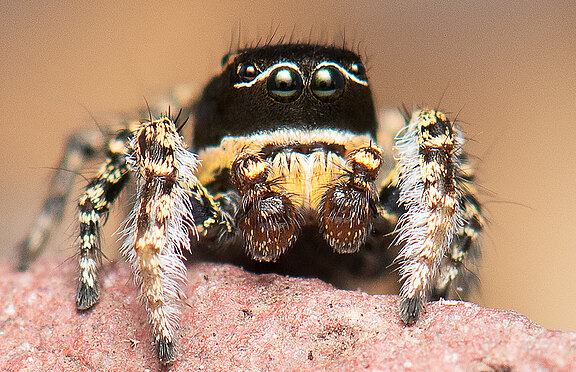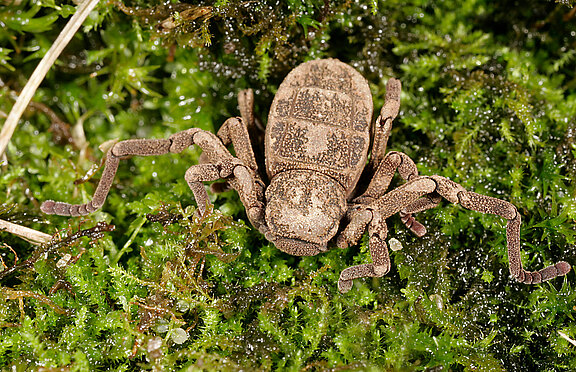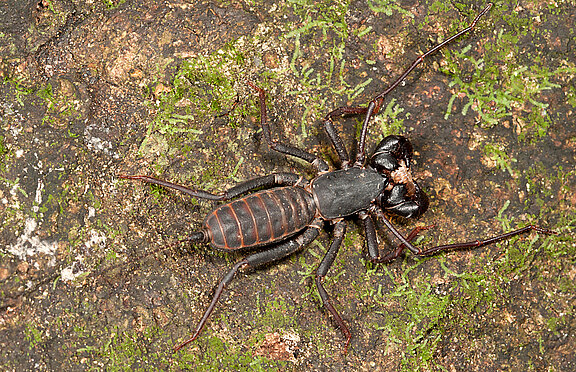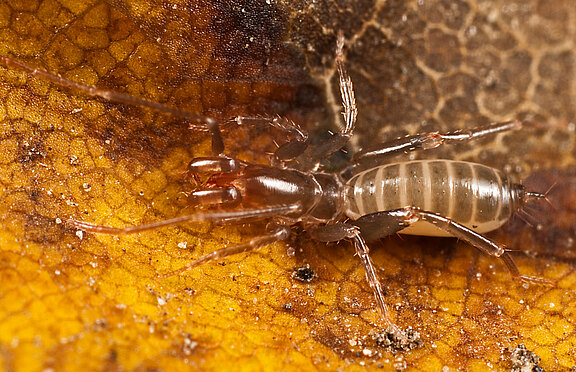List of all articles
Volume 50 Number 1
Quality microhabitat, scorpion size, scorpion height, scorpion diet, caterpillar prey
Abstract
Microhabitat use by predators can be influenced by prey availability, predator size and risk of cannibalism. The preferred microhabitat for a predator can be for foraging, feeding or as a refuge. In this study in south Texas, Centruroides vittatus (Say, 1821) of all size classes utilized both ground and vegetation microhabitats. There was a high proportion of scorpions with caterpillars in legumes and low proportion of scorpions with any of the prey types on the ground. The median height of scorpions with prey did vary, with scorpions on legumes with caterpillar prey the highest and scorpions on other vegetation with dangerous prey the lowest. Intermediate size scorpions used legumes at a high frequency during January–April, and large scorpions used succulents at very high frequency during September–December. Scorpions climbed higher in blackbrush and other legumes than in other vegetation types. These results suggest that scorpions are actively foraging for caterpillars in legumes, and legumes are a quality microhabitat for foraging. The low proportion of scorpions with prey on the ground suggests that C. vittatus feed on prey on vegetation even if the prey was captured on the ground. A possible advantage for the scorpion to handle and consume prey on vegetation is lower predation risk or interference while feeding. The high use of succulents by the large scorpions cannot be explained by foraging success. A possibility is that succulents are preferred refuges by all C. vittatus but smaller scorpions avoid succulents because of the risk of cannibalism by the larger scorpions.
Volume 50 Number 1
Laniatores, Cuba, troglobite, male dimorphism, population ecology.
Abstract
The troglobitic harvestman Jimeneziella decui Avram, 1970 is known from four neighboring caves (Cueva de Majana, Cueva de los Golondrinos, Cueva Perla del Agua, and Cueva de Máximo) located in eastern Cuba. We present the first ecological data on a population of this endangered species in Cueva de Máximo. The sex ratio of the population estimated in the main gallery of the cave was not different from 1:1. The spatial distribution observed was uniform, and the density of individuals was 0.48 individuals/m2 (February–March) and 0.84 individuals/m2 (November). We describe morphological differences between the sexes and between males. Preliminary morphological and behavioral data suggests the possible existence of two male morphs in J. decui (“robust” and “slender” males). The slender males possessed less developed armature on leg IV; and the chelicerae, coxa IV and femur IV were less swollen than robust males. Our observations on male-male interactions suggest that robust males are more aggressive than slender males, which never initiated an attack on robust males, but in some occasions responded to attacks from robust males. The non-aggressive behavior exhibited by robust males towards slender males also suggests that the slender morph is not only a sneaker, but potentially a female mimic, which is also consistent with the morphology of slender males. Ecological and behavioral information also suggests the possible existence of territories defended by robust males with their well-developed weapons, and the presence of females inside them.
Volume 50 Number 1
Arachnida, nomenclature, systematics, taxonomy.
Abstract
The World Arachnida Catalog (WAC, online at https://wac.nmbe.ch) is introduced as an amalgamation of the highly successful World Spider Catalog (WSC), the Pseudoscorpions of the World Catalog, and the Smaller Arachnid Order Catalogs. The new catalogs present all available taxonomic information on eight arachnid orders (Amblypygi, Araneae, Pseudoscorpiones, Ricinulei, Palpigradi, Schizomida, Solifugae and Uropygi) in a single location and a standardized format, continuously updated by specialists, to members of the World Spider Catalog Association (WSCA). For the first time, the majority of taxonomic literature for Pseudoscorpiones and the smaller arachnid orders will be available in downloadable PDF format for members according to the Swiss copyright laws. Up-to-date counts of families, genera and species are given alongside the current taxonomy for each taxon. Now in a common place and presented in an almost unified format, the new catalog aims to become the primary repository of taxonomic information for the Arachnida and will hopefully stimulate arachnological research across all arachnid orders by removing boundaries imposed by literature accessibility, incompatibility of formats, or taxonomic jargon.
Volume 49 Number 3
Araneae, disease, infection, araneopathogen, host behavior
Abstract
Parasites are some of the most abundant, diverse, and ecologically important organisms on the planet. Similarly, spiders are diverse, abundant, and play important roles in many terrestrial ecosystems. It is unfortunate that our understanding of the parasites that affect spiders is so underdeveloped relative to similar fields (e.g., parasites of insects). With this review, we describe characteristics of the major groups known to parasitize spiders and illustrate the ways in which spider biology presents unique challenges and opportunities for their parasites. Particularly promising avenues of future research include testing how parasites alter their spider hosts’ behavior and ecology through density-dependent and trait-mediated effects. We close by providing future directions and testable hypotheses at the forefront of spider-parasite research.
Volume 49 Number 3
Sexual selection, sexual conflict, cryptic female choice, sperm competition, Solifugae
Abstract
The exploration of new and diverse animal groups in the study of sexual selection is both necessary and important to help better understand broad patterns and test sexual selection hypotheses regarding the evolutionary origins and maintenance of reproductive tactics and associated traits. Solifuges are, in this matter, an exceptional group and very little explored from the sexual selection point of view. At first glance, mating is apparently quite simple and conserved within this arachnid order, but solifuge reproductive behavior is unique among arachnids and more diverse than previously thought. In particular, these voracious animals appear to exhibit high sexual conflict, as males need to avoid being eaten by their aggressive female partners and mating encounters in some species involve periods of apparently male-induced female inactivity during sperm transfer. The extent to which reproductive encounters are coercive versus collaborative, however, remains largely unknown. In this review, we begin with a historical perspective of sexual behavior research in solifuges. We then discuss precopulatory mating patterns, the role of the female and male during mating, sexual dimorphism, and the influence of sexual selection during different stages of mating. In addition, we explore cases of sexual cannibalism and provide an updated analysis of how postcopulatory sexual selection may be acting on these amazing arachnids. This review shows that there is much to be done in this extraordinary group of animals.
Volume 49 Number 3
Orb webs, spider size, web asymmetry, web inclination.
Abstract
The design of orb webs is affected by multiple abiotic (e.g., wind, available space), biotic (e.g., prey availability, predation), and species specific (e.g., spider size) factors. Thus, some features of each spider web are expected to reflect the combined effect of such factors. We compared the relationship of spider size and web inclination on the area of different sections of the orb web and other features (e.g., number or radii) between two sympatric Leucauge species (Leucauge sp., and L. argyra (Walckenaer, 1841), Tetragnathidae). Leucauge sp. was smaller and constructed smaller webs across a wider range of inclinations than L. argyra. Other features of the web, e.g., capture area, and hub area, but not the number of adhesive spiral turns and number of radii, were also larger in webs of L. argyra. The inclination was greater in webs of Leucauge sp., but the asymmetry of webs did not differ between species, though, it correlated negatively with the total area of the web of both species, as in other orb-weavers. The characteristics of each species’ web suggest that L. argyra optimizes prey interception, while Leucauge sp. optimizes stopping and retention of large prey.
Volume 49 Number 3
Salticidae, chemical defense, toxin susceptibility, aposematism, predation
Abstract
A key challenge for generalist predators is avoiding toxins in prey. Species-specific strategies range from total avoidance of distasteful (and potentially toxic) prey to the use of physiological mechanisms to metabolize toxins after consumption. We compare two species of jumping spiders, Habronattus trimaculatus Bryant, 1945 and Phidippus regius CL Koch, 1846. Based on several anecdotal observations and other aspects of their biology, we hypothesized a priori that H. trimaculatus would be (1) less willing to feed on unpalatable prey and (2) more susceptible to toxins that are consumed compared with P. regius. In Experiment 1, we presented spiders of both species with size-matched quinine-dipped crickets. Consistent with our hypothesis, all H. trimaculatus attacked and rejected them while all P. regius attacked and consumed them. In Experiments 2 and 3, we assigned spiders of both species to experimental feeding treatments with varying levels of toxicity (using toxic springtails, Folsomia candida) and assessed effects on their growth. Spiders of both species readily fed on the springtails. Collectively, results from these two experiments suggest that springtails have negative effects on both species, but that these effects are stronger in H. trimaculatus. Habronattus FO Pickard-Cambridge, 1901 has a unique red retinal filter pigment (not found in Phidippus CL Koch, 1846) that likely improves their ability to discriminate reds and oranges. The evolution of this unique visual system may have been driven by their heightened susceptibility to prey toxins, and thus the benefits of avoiding prey that advertise toxins with long-wavelength colors.
Volume 49 Number 3
Cribellate webs, garden, house, transport
Abstract
Badumna longinqua (L. Koch, 1867) (Araneae: Desidae) is a web-building spider indigenous to eastern and southern Australia; it has been introduced to several countries in North and South America, as well as New Zealand, Japan and Germany. In South Africa, where it was formally recorded for the first time a decade ago, B. longinqua has been sampled from the southern coastal areas (Eastern and Western Cape provinces) and central Free State Province, with almost all of the records associated with synanthropic urban habitats. We present a brief account of its invasion history in the country. Predictive ecological niche models suggest that only the southern coastal areas represent suitable habitat. This suggests that samples from the Free State (only in horticultural nurseries) can be attributed to regular translocations from the southern coastal areas, but that an unsuitable climate there prevents long-term establishment. Future climate change may further restrict this species, which prefers year-round warm, humid areas with low seasonal variability, climatic conditions that are predicted to become increasingly rare in South Africa.
Volume 49 Number 3
Reproduction, maternal care, egg sac camouflage, concealment of egg sac, Serra do Japi.
Abstract
Spiders exhibit various egg sac construction behaviors using camouflage to protect the eggs from predators and parasitoids and also perform parental care to increase offspring survival. In this study, we describe the egg sac construction behavior of Deinopis cf. cylindracea, and the camouflage characteristics of egg sac when left without the female’s active protection. Our observations showed that D. cf. cylindracea builds a fairly compact egg sac, with an outermost layer composed of dense silk. This outermost layer is dark brown, perhaps to camouflage with the substrate on which the egg sac is deposited. Moreover, females tend to hide their egg sacs with dry leaves in the litter. In addition, the overall color, shape, and size of the egg sac resemble the dry seeds of Plinia cauliflora, the plant on which D. cf. cylindracea was found. Two female spiders were positioned on their egg sacs; however, whether this behavior reflects maternal care remains unknown. Therefore, the overall egg sac construction behavior of D. cf. cylindracea may be related to a strategy for increasing fitness. This is the first behavioral record for a South American deinopid species.
Volume 49 Number 3
Courtship plasticity, reproductive behavior, male-male competition, eavesdropping, substrate-borne vibration.
Abstract
In the context of competitive mate searching, males may use cues from conspecifics, such as movement cues and/or courtship signals, to locate mates. For ground-dwelling wolf spiders, substrate-borne vibratory cues may be particularly important sources of information, given the potential presence of many visual obstacles. This study explores the possible use of conspecific male cues in wolf spiders by asking: (i) Do male Schizocosa retrorsa (Banks, 1911) wolf spiders use vibratory cues from conspecific males to alter their searching or signaling behavior? (ii) Can males assess the density of conspecific males using conspecific male cues? (iii) Does the variation in conspecific male density affect the behavioral response of focal males to the conspecific cues? To answer these questions, we tested the effects of (i) the number of conspecific males and (ii) the activity of conspecific males (e.g., courtship yes/no) on a focal male’s behavior. We recorded the following focal male behavior: (a) the presence/absence of courtship behavior, (b) temporal/structural signal characteristics of the multimodal courtship signaling, and (c) locomotory patterns. Our results suggest that, (i) S. retrorsa males assess their competitive environment through substrate-borne vibratory cues generated by courting or non-courting behavior of conspecific neighbors, (ii) S. retrorsa males may alter their reproductive behavior between mate searching and courtship signaling by the assessment of cues associated with conspecific male density, and (iii) the assessment and perception of density-dependent conspecific courtship signaling can be used as social information to adjust the reproductive behavior.
Volume 49 Number 3
Arachnida, harvestmen, Grassatores, Asia, Indo-Malaya, chaetotaxy
Abstract
A description of the pattern of structure and organization of the penial macrosetae was recently put forward for Gonyleptoidea Sundevall, 1833 and demonstrated to occur also in other families of Grassatores Kury, 2002, such as Assamiidae Sørensen, 1884, Epedanidae Sørensen, 1886 and Pyramidopidae Sharma, Prieto & Giribet, 2011. This set of homology hypotheses is herein called AE11 pattern. In this work, the monotypic Sri Lankan genus Eurytromma Roewer, 1949 of the family Podoctidae Roewer, 1912 (which is currently assigned to the Epedanoidea in the Grassatores) is studied. Male genitalia of Eurytromma are described for the first time and the first attempt is made to reconcile the chaetotaxy of ventral plate of podoctid species with the AE11 pattern. The podoctid genera Hoplodino Roewer, 1915, Strandibalonius Roewer, 1912 and Santobius Roewer, 1949 are also exemplified here; their set of macrosetae is described and the AE11 pattern is demonstrated to occur in all of them. Therefore, AE11 is more phylogenetically widespread in the Grassatores than previously thought. Eurytromma pictulum (Pocock, 1903) from Sri Lanka is redescribed. It is characterized by the presence of a meso-frontal stridulatory saw of denticles on the cheliceral hand and extreme reduction of mesotergal sutures. A further refinement is made on the current terminology system of cheliceral dentition of Podoctidae.
Volume 49 Number 3
Whip scorpion, spermatophore, fecundity, giganteus
Abstract
Courtship and mating behavior in the vinegaroon, Mastigoproctus tohono Barrales-Alcala ́, 2018, is an elaborate, multistep, and long-lasting procedure. It consists of four major stages: Chase and Grapple, Dancing, Generating, and Pressing, with subtle behaviors occurring within the stages. Courtship occurs during nighttime and requires on average nearly 13 hours for completion. Especially in the beginning of the courtship, females will often resist the advances of the male and even during later stages can escape and terminate the courtship. On average, wild caught female vinegaroons produce 52 young whose combined initial weight can exceed that of the female. These 1st instar free- living young share the burrow with their mother during the early activity period of the summer. The female exhibits maternal care including feeding prey that she catches to her new young. Vinegaroons have four immature free-living instars before molting to the adult. Each instar requires at least one year, and sometimes more than one year, before molting to the next instar. Adults can live up to four years during which time they never molt. Females can produce a litter of young during each of their second and third summer seasons. The usual lifespan of a vinegaroon from egg to death ranges from 7 to 9 years.
Volume 49 Number 3
Araneae, atmospheric electricity, ballooning, Linyphiidae, tiptoe behavior
Abstract
Observations of spiders’ pre-dispersal behavior can be used to answer various ecological and evolutionary questions. So far, dispersal experiments have often used air currents as a stimulating factor. Effects of electric fields on the pre-dispersal behavior of spiders have recently been discovered. Electric fields may lead to unexplained variation in results and limit comparability between previous studies. Here we aim to disentangle the roles of wind and electric fields on the passive aerial dispersal of three linyphiid spider species. Our results confirm that strong electric fields in the air elicit pre- dispersal behavior, and in combination with a light wind, facilitate dispersal (take-off). Nevertheless, even the strong electric fields employed here played a rather supplementary role in spiders’ dispersal with wind remaining the most influential factor. We recommend that studies of passive aerial dispersal should control for electric field strength but otherwise use wind as the primary stimulating factor.
Volume 49 Number 3
Cheliceral morphology, spinneret morphology, aciniform wrapping lines, silk-degrading enzyme
Abstract
The large size and slow movements of mature female Trichonephila clavipes (Linnaeus, 1767) permit observations of some seldom-studied details of behavioral processes, such as cutting and initiating silk lines, that help clarify functional morphology. Silk lines were cut after being grasped by the cheliceral fangs; but direct observation and details of cheliceral morphology showed that cutting was not accomplished mechanically, as has sometimes been assumed. Lines were probably cut by contact with an enzyme in the mouth region. Initiation of wrapping lines involved rapid, coordinated movements of the spinnerets and the abdomen that caused the spigots for these lines to brush against each other and dragline silk. The posterior lateral spinnerets were spread widely during wrapping; this behavior and the positions of spigots on the spinnerets probably serve to widen the swath of wrapping lines applied to the prey.
Volume 49 Number 3
Stabilimenta, citizen science
Abstract
Spiders in the genus Argiope Audouin, 1826 often include silken structures in their webs called decorations. Here, I report on the form and frequency of the vertical or linear decorations built by A. protensa L. Koch, 1872 as based on a survey of online digital imagery. Of 124 webs in 262 images clearly showing the web, 38.7% were decorated, less than for other congeners also sampled across their geographic range. The spider lays silk strips centered above and/or below the web’s hub; however, one web appeared to have four strips arranged in a cruciate pattern. Unlike other Argiope whose decorations consist of zigzagging bands, A. protensa weaves a derived cottony decoration of jagged strips reminiscent of those in Uloboridae. Large and geographically broad surveys of spider behavior and web structure are possible using online databases of natural-history observations.
Volume 49 Number 3
Aviculariinae, Cerrado, predator-prey, spider predation, trophic interaction
Abstract
Reports of tarantulas feeding on birds are rare and were a matter of intense debate among naturalists for centuries. The first account dates from the early eighteenth century by the German naturalist Marie Sibylla Merian, and since then only a few reliable predation events have been published. We herein report on a predation event by the arboreal tarantula Iridopelma vanini Bertani, 2012 on two Southern house wrens Troglodytes musculus Naumann, 1823 in Brazil. The spider, a male, was found feeding on a young bird on a signpost made of two wooden posts, at dusk. The following day, one of the posts was removed and the spider was found feeding on a second young bird on its nest. We also update and discuss the identification of the theraphosids involved in predation events reported in previous works.
Volume 49 Number 3
Large salticids, predation, Dactyloidae, Gekkonidae, Hylidae, Ranixalidae, bird hatchlings
Abstract
In this paper, vertebrate predation by jumping spiders (Salticidae) was revisited, taking into account incidents of this kind recently published in the scientific literature or on the internet. Our study revealed that vertebrate predation by salticids is more widespread than previously thought, geographically and taxonomically. Roughly ninety percent of all reported cases refer to predation on anurans (Hylidae and Ranixalidae) and lizards (Dactyloidae and Gekkonidae) by salticids from the subfamily Salticinae (Hyllus spp., Phidippus spp., and an unidentified species presumably related to Hasarius Simon, 1871). In the remaining cases, salticids from the subfamily Salticinae (Paraphidippus cf. aurantius (Lucas, 1833) and Phidippus audax (Hentz, 1845)) were observed attacking bird hatchlings (families Paridae and Trochilidae), weighing ’4–6 times more than the spiders. In two instances, the spiders were observed biting the hatchlings, but only in one single case, a salticid was seen feeding on a hatchling.
Volume 49 Number 3
defensiveness, ethology; venom optimization hypothesis
Abstract
Scorpion venom is composed mainly of peptides and proteins and has high metabolic cost. Thus, individuals need to be economic in its use. This study aimed to evaluate the reactions of Tityus pusillus Pocock, 1893 scorpion to threats of different intensities. For the experiments, 28 males and 26 females were used; animals were gently touched five times on their mesosoma at different time intervals. Touches with five second intervals were considered as the high- intensity threats, while those with five-minute intervals were considered as the low-intensity threats. We found that scorpions, independently of sex, stung more often under high threat compared to low threat treatments. However, no significant differences in the defensive behavior of males and females were observed according to threat intensity. We can thus infer that regardless of sex, T. pusillus uses its stings and consequently venom only in situations of high threat.
Volume 49 Number 3
Amblypygid, carrion, facultative, scavenger.
Abstract
Necrophagy is a feeding strategy in which animals feed on carrion; most scavengers are facultative and can also be predators or consumers. For amblypygids, necrophagy is a poorly documented phenomenon and there are literature records of individuals of three different species feeding on dead bats inside caves. In the present note, we document for the first time a necrophagic behavior in the whip spider Paraphrynus raptator (Pocock, 1902) which was observed feeding on Otonyctomys hatti Anthony, 1932 (Rodentia: Cricetidae) and a yucatan poorwill, Nyctiphrynus yucatanicus Hartert, 1892 (Caprimulgi- formes: Caprimulgidae) carrion. We made the observations inside a small chamber in an ancient Mayan temple inhabited by a group of woolly false vampire bats (Chrotopterus auritus Peters, 1856) in southeastern Mexico. Carrion consumption in P. raptator is directly related with the carnivorous feeding behavior of the C. auritus group with which they coexist.
Volume 49 Number 3
Development, parental care, Thelyphonida
Abstract
The scattered literature on schizomid brooding is reviewed and discussed in reference to the number of eggs, number and position of young as well as the brood chamber. In addition, novel brooding observations are provided for the Neotropical species Hansenochrus tobago (Rowland & Reddell, 1979), Dumitrescoella decui (Dumitresco, 1977), Piaroa sp. and Surazomus sp.
Volume 49 Number 2
Agave, Arizona, microhabitat, sotol, yucca
Abstract
Paraphidippus basalis (Banks, 1904) is a large jumping spider that occurs in the sky islands of the southwestern United States and northern Mexico. To date, P. basalis has only been incidentally reported on rosette-forming plants in the family Asparagaceae (yucca, agave, and sotol), even though the sky islands support a rich and diverse vegetation community. This apparent specialization is unusual because jumping spiders do not typically have strong associations with the plants on which they live. However, given that the ecology of P. basalis has yet to be studied, the microhabitat preferences of P. basalis remain unclear. We investigated microhabitat choice in P. basalis in the Patagonia Mountains of southeastern Arizona, to determine whether these spiders were specifically associated with rosette-forming plants. We surveyed 160 plots for jumping spiders, 80 with rosette-forming plants and 80 without. P. basalis was found only in rosette- forming plants, whereas other species of jumping spiders showed no preference for rosette or control plots. Larger rosette plants were more likely to contain P. basalis. This study provides an unusual example of host plant structural specificity in a jumping spider.
Volume 49 Number 2
Phylogeny, behavioral modules, combing behavior, categorizing web designs
Abstract
Studies of web evolution in spiders generally focus on the overall designs of webs in the field. As has been typical for dictynids and several other cribellate families with ‘‘irregular’’ webs, this study detected few discernable patterns in the field regarding the spatial organization of the highly variable, three-dimensional and largely aerial webs of the dictynid Dictyna meditata Gertsch, 1936. Nevertheless, there were three consistent sub-unit designs in the additions that spiders made to their webs in captivity, and in webs that they built from scratch in captivity: ‘‘silk ladders’’, with a cribellum line that zig-zagged between a pair of approximately parallel non-sticky lines; ‘‘twig ladders’’, with a cribellum line that zig-zagged between a non-sticky line and the substrate; and long non-sticky lines that each supported a long, slightly looped cribellum line. I suggest, using examples from dictynids and other families with long-lived, geometrically irregular webs, that this pattern of using consistent behavior patterns to add geometrically regular ‘‘modules’’, is widespread and ancient, but has often been missed due to damage and additions to webs in the field, and to lack of direct behavioral observations. Recent attempts to link web evolution to studies of spider phylogeny could benefit from a change of emphasis, focusing on the additions that spiders make to their webs, rather than on the currently common but necessarily vague characterizations of overall web designs seen in the field.


